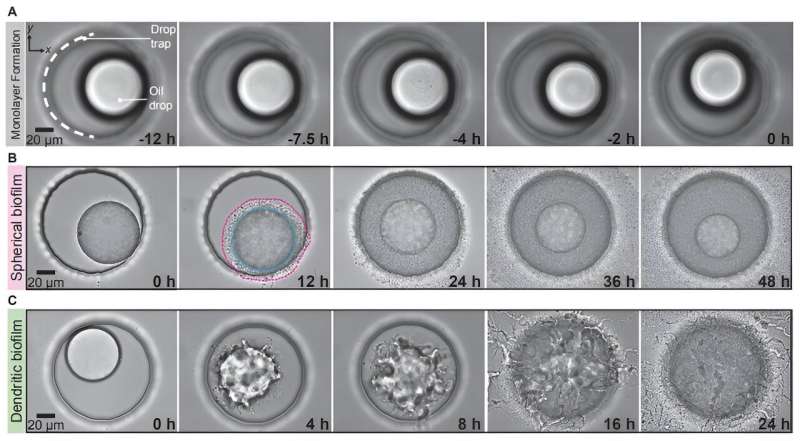Oil eating microbes reshape droplets to optimize biodegradation
Originally published by by Bob Yirka , Phys.org, on August 18, 2023
Bright-field sequences showing biofilm phenotypes. (A) Time-lapse sequence showing the formation of a monolayer on a trapped drop. The edge of the drop trap is indicated by the white dashed line. The confluent monolayer is formed at t0 (t = 0 h). (B) Development of a spherical biofilm (SB) on an oil drop. The oil drop radius monotonically decreases in time. At 12 h, the droplet is outlined with a cyan line and the biofilm is outlined by a magenta line, as a guide for the reader. (C) Time-lapse sequence showing the development of a dendritic biofilm (DB) on an oil drop. The biofilm deforms the surface, initially generating wrinkles and protrusions, that fragmenting the droplet into tube-like segments and numerous smaller irregularly shaped volumes of oil covered with cells at later times. Credit: Science (2023). DOI: 10.1126/science.adf3345
A team of French and Japanese environmental scientists has found that one kind of oil-eating microbe reshapes droplets to optimize biodegradation. In their study, reported in the journal Science, the group isolated Alcanivorax borkumensis bacteria specimens in a lab setting, fed them crude oil, and then watched how they worked together to eat the oil as quickly and efficiently as possible. Terry McGenity and Pierre Philippe Laissue with the University of Essex's School of Life Sciences have published a Perspective piece in the same journal issue describing the work.
Prior research has shown that there are many microbes living in the ocean that feed on oil, eventually cleaning away oil not cleaned up by human efforts. Prior research has also shown that such microbes are not able to consume crude oil until it disperses into droplets, which can take a long time. In this new effort, the researchers sought to learn more about the process of crude oil consumption by sea microbes. To that end, they collected A. borkumensis specimens and tested them in their lab.


Comments
Post a Comment